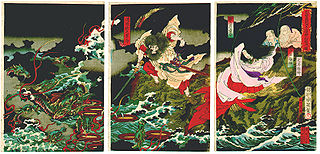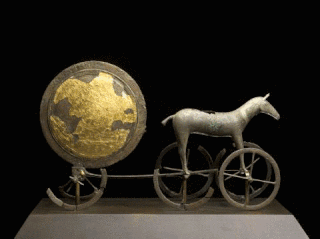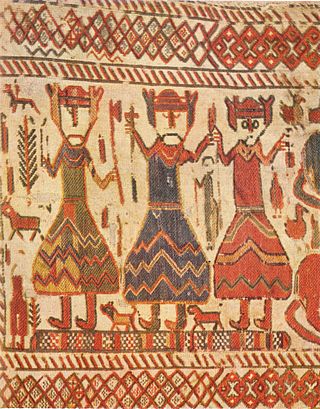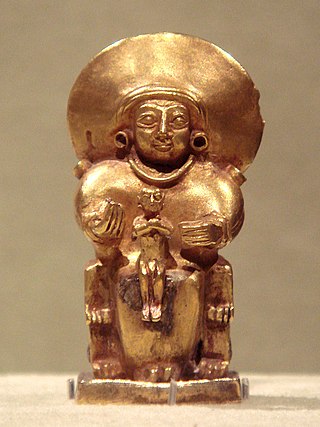Serpent-slaying myth
| Part of a Mythology series on |
| Chaoskampf or Drachenkampf |
|---|
 |
| Comparative mythology of sea serpents, dragons and dragonslayers. |
One common myth found in nearly all Indo-European mythologies is a battle ending with a hero or god slaying a serpent or dragon of some sort. [16] [17] [18] Although the details of the story often vary widely, several features remain remarkably the same in all iterations. The protagonist of the story is usually a thunder-god, or a hero somehow associated with thunder. [19] His enemy the serpent is generally associated with water and depicted as multi-headed, or else "multiple" in some other way. [18] Indo-European myths often describe the creature as a "blocker of waters", and his many heads get eventually smashed up by the thunder-god in an epic battle, releasing torrents of water that had previously been pent up. [20] The original legend may have symbolized the Chaoskampf, a clash between forces of order and chaos. [21] The dragon or serpent loses in every version of the story, although in some mythologies, such as the Norse Ragnarök myth, the hero or the god dies with his enemy during the confrontation. [22] Historian Bruce Lincoln has proposed that the dragon-slaying tale and the creation myth of *Trito killing the serpent *H₂n̥gʷʰis may actually belong to the same original story. [23] [6] Reflexes of the Proto-Indo-European dragon-slaying myth appear in most Indo-European poetic traditions, where the myth has left traces of the formulaic sentence *(h₁e) gʷʰent h₁ógʷʰim, meaning "[he] slew the serpent". [24]

In Hittite mythology, the storm god Tarhunt slays the giant serpent Illuyanka, [25] as does the Vedic god Indra the multi-headed serpent Vritra, which has been causing a drought by trapping the waters in his mountain lair. [20]
[26] Several variations of the story are also found in Greek mythology. [27] The original motif appears inherited in the legend of Zeus slaying the hundred-headed Typhon, as related by Hesiod in the Theogony , [17] [28] and possibly in the myth of Heracles slaying the nine-headed Lernaean Hydra and in the legend of Apollo slaying the earth-dragon Python. [17] [29] The story of Heracles's theft of the cattle of Geryon is probably also related. [17] Although he is not usually thought of as a storm deity in the conventional sense, Heracles bears many attributes held by other Indo-European storm deities, including physical strength and a knack for violence and gluttony. [17] [30]
The original motif is also reflected in Germanic mythology. [31] The Norse god of thunder Thor slays the giant serpent Jörmungandr, which lived in the waters surrounding the realm of Midgard. [32] [33] In the Völsunga saga , Sigurd slays the dragon Fafnir and, in Beowulf , the eponymous hero slays a different dragon. [34] The depiction of dragons hoarding a treasure (symbolizing the wealth of the community) in Germanic legends may also be a reflex of the original myth of the serpent holding waters. [24]

In Zoroastrianism and in Persian mythology, Fereydun (and later Garshasp) slays the serpent Zahhak. In Albanian mythology, the drangue, semi-human divine figures associated with thunders, slay the kulshedra, huge multi-headed fire-spitting serpents associated with water and storms. The Slavic god of storms Perun slays his enemy the dragon-god Veles, as does the bogatyr hero Dobrynya Nikitich to the three-headed dragon Zmey. [32] A similar execution is performed by the Armenian god of thunders Vahagn to the dragon Vishap, [35] by the Romanian knight hero Făt-Frumos to the fire-spitting monster Zmeu, and by the Celtic god of healing Dian Cecht to the serpent Meichi. [21]
In Shinto, where Indo-European influences through Vedic religion can be seen in mythology, the storm god Susanoo slays the eight-headed serpent Yamata no Orochi. [36]
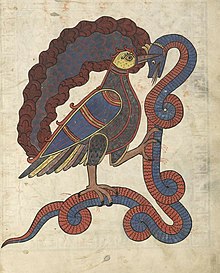
The Genesis narrative of Judaism and Christianity, as well as the dragon appearing in Revelation 12 can be interpreted[ by whom? ] as a retelling of the serpent-slaying myth. The Deep or Abyss from or on top of which God is said to make the world is translated from the Biblical Hebrew Tehom (Hebrew: תְּהוֹם). Tehom is a cognate of the Akkadian word tamtu and Ugaritic t-h-m which have similar meaning. As such it was equated with the earlier Babylonian serpent Tiamat. [37]
Folklorist Andrew Lang suggests that the serpent-slaying myth morphed into a folktale motif of a frog or toad blocking the flow of waters. [38]


